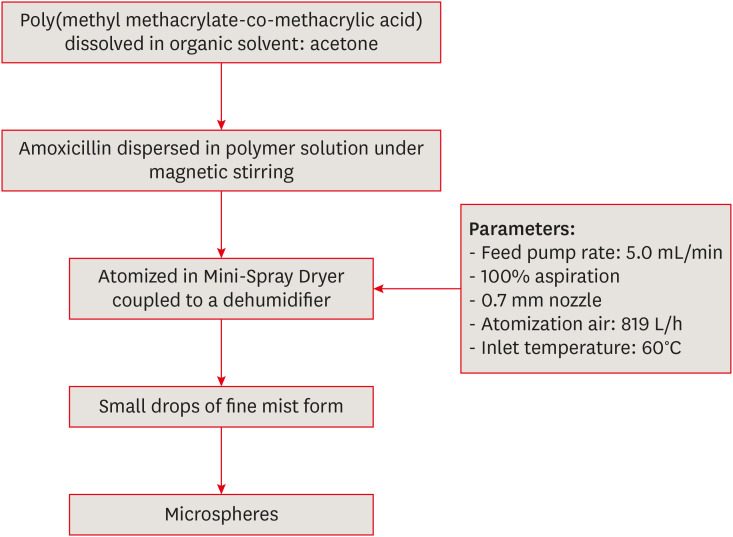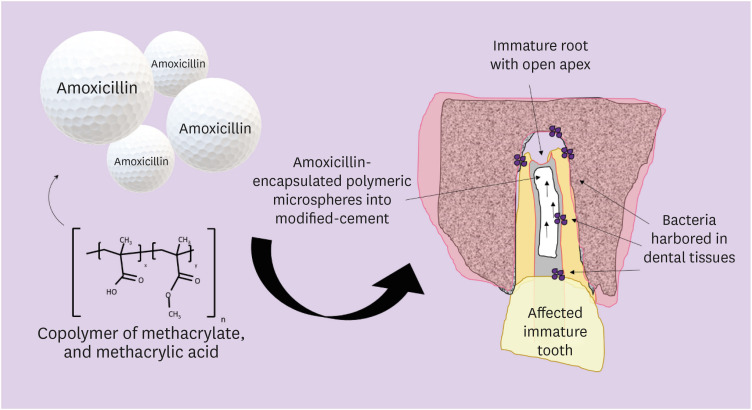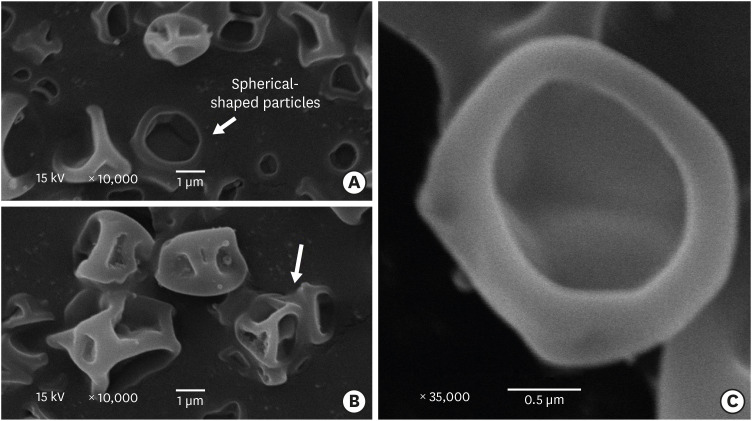Articles
- Page Path
- HOME > Restor Dent Endod > Volume 45(4); 2020 > Article
-
Research Article
Incorporation of amoxicillin-loaded microspheres in mineral trioxide aggregate cement: an
in vitro study -
Fábio Rocha Bohns1
 , Vicente Castelo Branco Leitune1
, Vicente Castelo Branco Leitune1 , Isadora Martini Garcia1
, Isadora Martini Garcia1 , Bruna Genari1,2
, Bruna Genari1,2 , Nélio Bairros Dornelles1
, Nélio Bairros Dornelles1 , Silvia Stanisçuaski Guterres3
, Silvia Stanisçuaski Guterres3 , Fabrício Aulo Ogliari4
, Fabrício Aulo Ogliari4 , Mary Anne Sampaio de Melo5,6
, Mary Anne Sampaio de Melo5,6 , Fabrício Mezzomo Collares1
, Fabrício Mezzomo Collares1
-
Restor Dent Endod 2020;45(4):e50.
DOI: https://doi.org/10.5395/rde.2020.45.e50
Published online: October 7, 2020
1Department of Dental Materials, School of Dentistry, Federal University of Rio Grande do Sul, Porto Alegre, RS, Brazil.
2Department of Orthodontics and Biomaterials, Centro Universitário UDF, Brasília, DF, Brazil.
3Cosmetology Laboratory, School of Pharmaceutical Sciences, Federal University of Rio Grande do Sul, Porto Alegre, RS, Brazil.
4Yller Biomaterials, Pelotas, RS, Brazil.
5Program in Biomedical Sciences, University of Maryland School of Dentistry, Baltimore, MD, USA.
6Division of Operative Dentistry, Department of General Dentistry, University of Maryland School of Dentistry, Baltimore, MD, USA.
- Correspondence to Mary Anne Sampaio de Melo, DDS, MSc, PhD. Associate Professor, Division of Operative Dentistry, Department of General Dentistry, University of Maryland School of Dentistry, 650 W Baltimore St, Baltimore, MD 21201, USA. mmelo@umaryland.edu
- Correspondence to Fabrício Mezzomo Collares, DDS, MSc, PhD. Associate Professor, Department of Dental Materials, School of Dentistry, Federal University of Rio Grande do Sul, Rua Ramiro Barcelos, 2492 Rio Branco, Porto Alegre, RS 90035-003, Brazil. fabricio.collares@ufrgs.br
Copyright © 2020. The Korean Academy of Conservative Dentistry
This is an Open Access article distributed under the terms of the Creative Commons Attribution Non-Commercial License (https://creativecommons.org/licenses/by-nc/4.0/) which permits unrestricted non-commercial use, distribution, and reproduction in any medium, provided the original work is properly cited.
- 1,421 Views
- 11 Download
- 3 Crossref
Abstract
-
Objectives In this study, we investigated the potential of amoxicillin-loaded polymeric microspheres to be delivered to tooth root infection sites via a bioactive reparative cement.
-
Materials and Methods Amoxicillin-loaded microspheres were synthesized by a spray-dray method and incorporated at 2.5% and 5% into a mineral trioxide aggregate cement clinically used to induce a mineralized barrier at the root tip of young permanent teeth with incomplete root development and necrotic pulp. The formulations were modified in liquid:powder ratios and in composition by the microspheres. The optimized formulations were evaluated in vitro for physical and mechanical eligibility. The morphology of microspheres was observed under scanning electron microscopy.
-
Results The optimized cement formulation containing microspheres at 5% exhibited a delayed-release response and maintained its fundamental functional properties. When mixed with amoxicillin-loaded microspheres, the setting times of both test materials significantly increased. The diametral tensile strength of cement containing microspheres at 5% was similar to control. However, phytic acid had no effect on this outcome (p > 0.05). When mixed with modified liquid:powder ratio, the setting time was significantly longer than that original liquid:powder ratio (p < 0.05).
-
Conclusions Lack of optimal concentrations of antibiotics at anatomical sites of the dental tissues is a hallmark of recurrent endodontic infections. Therefore, targeting the controlled release of broad-spectrum antibiotics may improve the therapeutic outcomes of current treatments. Overall, these results indicate that the carry of amoxicillin by microspheres could provide an alternative strategy for the local delivery of antibiotics for the management of tooth infections.
INTRODUCTION
Illustrative scheme of a possible approach for the proposed bioactive dental cement with amoxicillin-loaded polymeric microspheres.

MATERIALS AND METHODS
Schematic demonstration of the synthesis route for microsphere preparation by spray-dry method.

Description of the composition from each group formulated in this study
RESULTS
Amoxicillin release profile of 5% microspheres loaded with amoxicillin
| Collection periods (hr) | Amoxicillin release (%) |
|---|---|
| 2 | 0.00 |
| 6 | 0.00 |
| 12 | 0.00 |
| 24 | 0.00 |
| 48 | 0.00 |
| 72 | 0.00 |
| 96 | 16.68 |
Setting times of tested cement formulations as the microsphere concentration increases. Values followed by the same letters are not significantly different (p > 0.05).

Diametral tensile strength (DTS) of the tested cement formulations according to microsphere concentration. Values followed by the same letters are not significantly different (p > 0.05).

DISCUSSION
CONCLUSIONS
ACKNOWLEDGMENTS
-
Conflict of Interest: No potential conflict of interest relevant to this article was reported.
-
Author Contributions:
Conceptualization: Leitune VCB, Ogliari FA, Collares FM.
Formal analysis: Bohns FR, Genari B, Dornelles NB Júnior, Collares FM.
Investigation: Bohns FR, Leitune VCB, Genari B, Dornelles NB Júnior, Guterres SS, Ogliari FA, Collares FM.
Project administration: Ogliari FA, Collares FM.
Resources: Ogliari FA, Collares FM.
Supervision: Leitune VCB, Ogliari FA, Collares FM.
Visualization: Bohns FR, Garcia IM, Melo MAS, Collares FM.
Writing - original draft: Bohns FR, Garcia IM, Collares FM.
Writing - review & editing: Melo MAS, Collares FM.
- 1. Ricucci D, Loghin S, Niu LN, Tay FR. Changes in the radicular pulp-dentine complex in healthy intact teeth and in response to deep caries or restorations: a histological and histobacteriological study. J Dent 2018;73:76-90.ArticlePubMed
- 2. Ricucci D, Siqueira JF Jr, Loghin S, Lin LM. Pulp and apical tissue response to deep caries in immature teeth: a histologic and histobacteriologic study. J Dent 2017;56:19-32.ArticlePubMed
- 3. Farges JC, Alliot-Licht B, Renard E, Ducret M, Gaudin A, Smith AJ, Cooper PR. Dental pulp defence and repair mechanisms in dental caries. Mediators Inflamm 2015;2015:230251.ArticlePubMedPMCPDF
- 4. Martin FE. Carious pulpitis: microbiological and histopathological considerations. Aust Endod J 2003;29:134-137.ArticlePubMed
- 5. Guerrero F, Mendoza A, Ribas D, Aspiazu K. Apexification: a systematic review. J Conserv Dent 2018;21:462-465.ArticlePubMedPMC
- 6. Flanagan TA. What can cause the pulps of immature, permanent teeth with open apices to become necrotic and what treatment options are available for these teeth. Aust Endod J 2014;40:95-100.ArticlePubMed
- 7. Conde MCM, Chisini LA, Sarkis-Onofre R, Schuch HS, Nör JE, Demarco FF. A scoping review of root canal revascularization: relevant aspects for clinical success and tissue formation. Int Endod J 2017;50:860-874.ArticlePubMedPDF
- 8. Felippe WT, Felippe MCS, Rocha MJC. The effect of mineral trioxide aggregate on the apexification and periapical healing of teeth with incomplete root formation. Int Endod J 2006;39:2-9.ArticlePubMed
- 9. Pace R, Giuliani V, Nieri M, Di Nasso L, Pagavino G. Mineral trioxide aggregate as apical plug in teeth with necrotic pulp and immature apices: a 10-year case series. J Endod 2014;40:1250-1254.ArticlePubMed
- 10. Torabinejad M, Nosrat A, Verma P, Udochukwu O. Regenerative endodontic treatment or mineral trioxide aggregate apical plug in teeth with necrotic pulps and open apices: a systematic review and meta-analysis. J Endod 2017;43:1806-1820.ArticlePubMed
- 11. Mohammadi Z, Shalavi S. Effect of hydroxyapatite and bovine serum albumin on the antibacterial activity of MTA. Iran Endod J 2011;6:136-139.PubMedPMC
- 12. Kim RJY, Kim MO, Lee KS, Lee DY, Shin JH. An in vitro evaluation of the antibacterial properties of three mineral trioxide aggregate (MTA) against five oral bacteria. Arch Oral Biol 2015;60:1497-1502.ArticlePubMed
- 13. Piluso S, Soultan AH, Patterson J. Molecularly engineered polymer-based systems in drug delivery and regenerative medicine. Curr Pharm Des 2017;23:281-294.ArticlePubMed
- 14. Merkle HP. Drug delivery's quest for polymers: where are the frontiers? Eur J Pharm Biopharm 2015;97:293-303.ArticlePubMed
- 15. Cuppini M, Zatta KC, Mestieri LB, Grecca FS, Leitune VCB, Guterres SS, Collares FM. Antimicrobial and anti-inflammatory drug-delivery systems at endodontic reparative material: synthesis and characterization. Dent Mater 2019;35:457-467.ArticlePubMed
- 16. Ghosh Dastidar D, Saha S, Chowdhury M. Porous microspheres: synthesis, characterisation and applications in pharmaceutical & medical fields. Int J Pharm 2018;548:34-48.ArticlePubMed
- 17. Gupta V, Khan Y, Berkland CJ, Laurencin CT, Detamore MS. Microsphere-based scaffolds in regenerative engineering. Annu Rev Biomed Eng 2017;19:135-161.ArticlePubMedPMC
- 18. Chawla A, Sharma P, Pawar P. Eudragit S-100 coated sodium alginate microspheres of naproxen sodium: formulation, optimization and in vitro evaluation. Acta Pharm 2012;62:529-545.PubMed
- 19. Kaur G, Grewal J, Jyoti K, Jain UK, Chandra R, Madan J. Oral controlled and sustained drug delivery systems: concepts, advances, preclinical, and clinical status. In: Grumezescu AM, editor. Drug targeting and stimuli sensitive drug delivery systems. Norwich, NY: William Andrew Publishing; 2018. p. 567-626.
- 20. Bolfoni MR, Pappen FG, Pereira-Cenci T, Jacinto RC. Antibiotic prescription for endodontic infections: a survey of Brazilian endodontists. Int Endod J 2018;51:148-156.ArticlePubMedPDF
- 21. Segura-Egea JJ, Gould K, Şen BH, Jonasson P, Cotti E, Mazzoni A, Sunay H, Tjäderhane L, Dummer PM. Antibiotics in endodontics: a review. Int Endod J 2017;50:1169-1184.ArticlePubMedPDF
- 22. Dornelles NB, Collares FM, Genari B, de Souza Balbinot G, Samuel SMW, Arthur RA, Visioli F, Guterres SS, Leitune VCB. Influence of the addition of microsphere load amoxicillin in the physical, chemical and biological properties of an experimental endodontic sealer. J Dent 2018;68:28-33.ArticlePubMed
- 23. Kokubo T, Takadama H. How useful is SBF in predicting in vivo bone bioactivity? Biomaterials 2006;27:2907-2915.ArticlePubMed
- 24. Ha WN, Nicholson T, Kahler B, Walsh LJ. Methodologies for measuring the setting times of mineral trioxide aggregate and Portland cement products used in dentistry. Acta Biomater Odontol Scand 2016;2:25-30.ArticlePubMedPMCPDF
- 25. Parhizkar A, Nojehdehian H, Asgary S. Triple antibiotic paste: momentous roles and applications in endodontics: a review. Restor Dent Endod 2018;43:e28.ArticlePubMedPMCPDF
- 26. Lee G, Chung C, Kim S, Shin SJ. Observation of an extracted premolar 2.5 years after mineral trioxide aggregate apexification using micro-computed tomography. Restor Dent Endod 2019;45:e4.ArticlePubMedPMCPDF
- 27. Cartagena AF, Esmerino LA, Polak-Junior R, Olivieri Parreiras S, Domingos Michél M, Farago PV, Campanha NH. New denture adhesive containing miconazole nitrate polymeric microparticles: antifungal, adhesive force and toxicity properties. Dent Mater 2017;33:e53-e61.ArticlePubMed
- 28. Gavini E, Bonferoni MC, Rassu G, Obinu A, Ferrari F, Giunchedi P. Biodegradable microspheres as intravitreal delivery systems for prolonged drug release. what is their eminence in the nanoparticle era? Curr Drug Deliv 2018;15:930-940.ArticlePubMed
- 29. Duarte MA, Demarchi AC, Yamashita JC, Kuga MC, Fraga SC. pH and calcium ion release of 2 root-end filling materials. Oral Surg Oral Med Oral Pathol Oral Radiol Endod 2003;95:345-347.PubMed
- 30. Javid B, Panahandeh N, Torabzadeh H, Nazarian H, Parhizkar A, Asgary S. Bioactivity of endodontic biomaterials on dental pulp stem cells through dentin. Restor Dent Endod 2019;45:e3.ArticlePubMedPMCPDF
- 31. Mestieri LB, Zaccara IM, Pinheiro LS, Barletta FB, Kopper PMP, Grecca FS. Cytocompatibility and cell proliferation evaluation of calcium phosphate-based root canal sealers. Restor Dent Endod 2019;45:e2.ArticlePubMedPMCPDF
- 32. Fridland M, Rosado R. Mineral trioxide aggregate (MTA) solubility and porosity with different water-to-powder ratios. J Endod 2003;29:814-817.ArticlePubMed
- 33. Basturk FB, Nekoofar MH, Günday M, Dummer PM. The effect of various mixing and placement techniques on the compressive strength of mineral trioxide aggregate. J Endod 2013;39:111-114.ArticlePubMed
- 34. Bouyarmane H, El Hanbali I, El Karbane M, Rami A, Saoiabi A, Saoiabi S, Masse S, Coradin T, Laghzizil A. Parameters influencing ciprofloxacin, ofloxacin, amoxicillin and sulfamethoxazole retention by natural and converted calcium phosphates. J Hazard Mater 2015;291:38-44.ArticlePubMed
REFERENCES
Tables & Figures
REFERENCES
Citations

- Local drug delivery for regeneration and disinfection in endodontics: A narrative review
Anu Elsa Swaroop, Sylvia Mathew, P. Harshini, Shruthi Nagaraja
Journal of Conservative Dentistry and Endodontics.2025; 28(2): 119. CrossRef - Modified Mineral Trioxide Aggregate—A Versatile Dental Material: An Insight on Applications and Newer Advancements
C. Pushpalatha, Vismaya Dhareshwar, S. V. Sowmya, Dominic Augustine, Thilla Sekar Vinothkumar, Apathsakayan Renugalakshmi, Amal Shaiban, Ateet Kakti, Shilpa H. Bhandi, Alok Dubey, Amulya V. Rai, Shankargouda Patil
Frontiers in Bioengineering and Biotechnology.2022;[Epub] CrossRef - Local Drug Delivery Systems for Vital Pulp Therapy: A New Hope
Ardavan Parhizkar, Saeed Asgary, Carlo Galli
International Journal of Biomaterials.2021; 2021: 1. CrossRef





Figure 1
Figure 2
Figure 3
Figure 4
Figure 5
Description of the composition from each group formulated in this study
| Group | Description | Liquid-to-powder ratio |
|---|---|---|
| Controlratio 0.3 | Tricalcium silicate, dicalcium silicate, tricalcium aluminate, calcium oxide, bismuth oxide | 0.30 mL/g |
| Controlratio 1.16 | Cement at the liquid-to-powder ratio of 1.16 | 1.16 mL/g |
| MSAMOX at 2.5% | Cement at the liquid-to-powder ratio of 1.16 + 2.5% microspheres loaded with amoxicillin | 1.16 mL/g |
| MSAMOX at 5% | Cement at the liquid-to-powder ratio of 1.16 + 5% microspheres loaded with amoxicillin | 1.16 mL/g |
Amoxicillin release profile of 5% microspheres loaded with amoxicillin
| Collection periods (hr) | Amoxicillin release (%) |
|---|---|
| 2 | 0.00 |
| 6 | 0.00 |
| 12 | 0.00 |
| 24 | 0.00 |
| 48 | 0.00 |
| 72 | 0.00 |
| 96 | 16.68 |

 KACD
KACD

 ePub Link
ePub Link Cite
Cite

